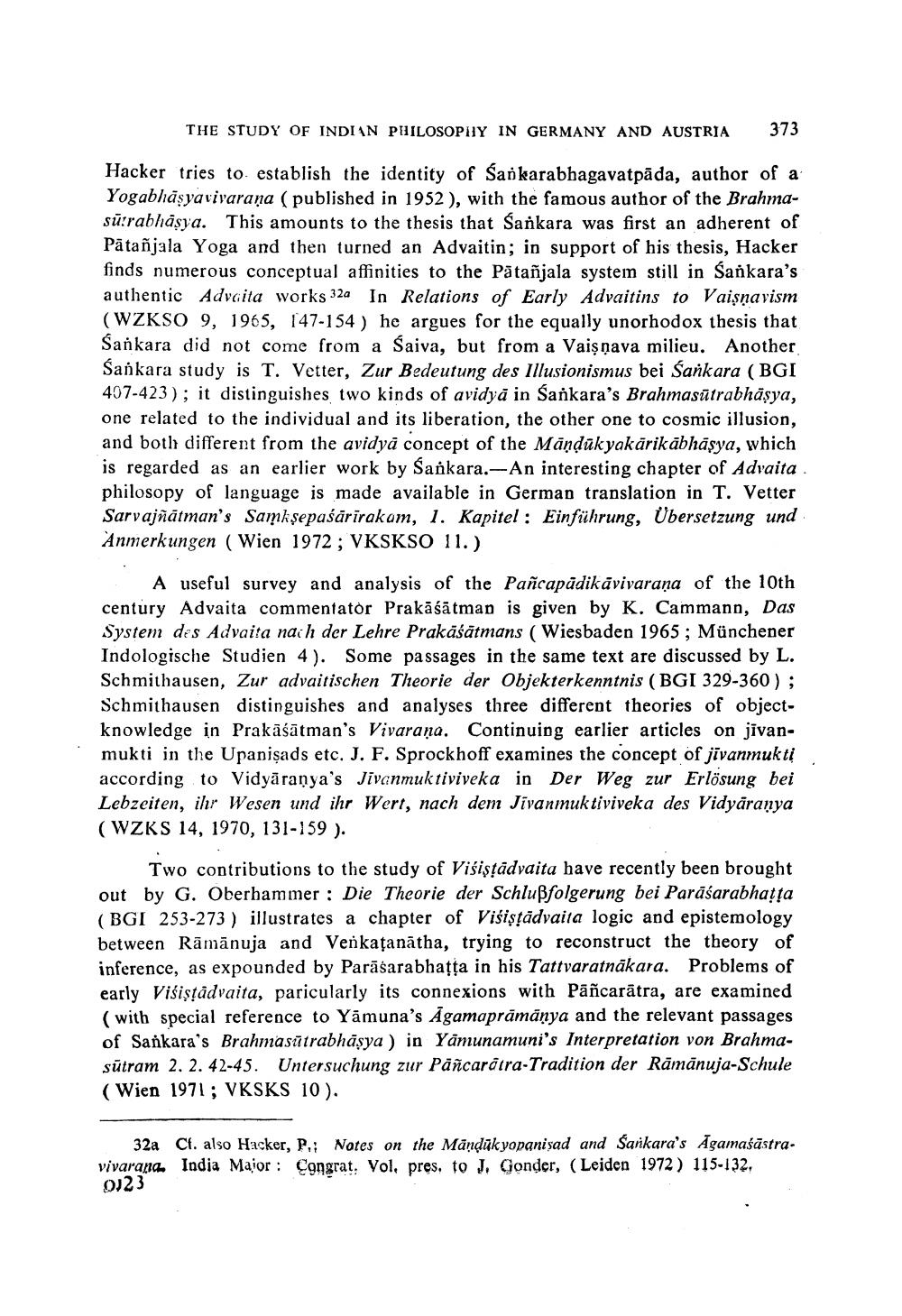________________
THE STUDY OF INDIAN PHILOSOPHY IN GERMANY AND AUSTRIA
373
Hacker tries to establish the identity of Sarkarabhagavatpāda, author of a Yogabhāşyavivarana (published in 1952), with the famous author of the Brahmasü:rabhásya. This amounts to the thesis that Sankara was first an adherent of Pātañjala Yoga and then turned an Advaitin; in support of his thesis, Hacker finds numerous conceptual affinities to the Patañjala system still in Sankara's authentic Advaita works 32a In Relations of Early Advaitins to Vaişņavism (WZKSO 9, 1965, 147-154 ) he argues for the equally unorhodox thesis that Sankara did not come from a Saiva, but from a Vaişnava milieu. Another Sankara study is T. Vetter, Zur Bedeutung des Illusionismus bei Sankara (BGI 497-423); it distinguishes two kinds of avidyā in Sankara's Brahmasūtrabhāșya, one related to the individual and its liberation, the other one to cosmic illusion, and both different from the avidyā concept of the Māņdūkyakārikābhāşya, which is regarded as an earlier work by Sankara.-An interesting chapter of Advaita philosopy of language is made available in German translation in T. Vetter Sarvajñātman's Samkṣepaśārīrakam, 1. Kapitel : Einführung, Übersetzung und Anmerkungen (Wien 1972; VKSKSO 11.)
A useful survey and analysis of the Pañcapūdikāvivarana of the 10th century Advaita commentator Prakāśātman is given by K. Cammann, Das System des Advaita nai h der Lehre Prakāśātmans (Wiesbaden 1965; Münchener Indologische Studien 4). Some passages in the same text are discussed by L. Schmithausen, Zur advaitischen Theorie der Objekterkenntnis (BGI 329-360); Schmithausen distinguishes and analyses three different theories of objectknowledge in Prakāśātman's Vivaraña. Continuing earlier articles on jīvanmukti in the Upanişads etc. J. F. Sprockhoff examines the concept of jīvanmukti according to Vidyāraṇya's Jivanmuktiviveka in Der Weg zur Erlösung bei Lebzeiten, ihr Wesen und ihr Wert, nach dem Jivanmuktiviveka des Vidyaranya (WZKS 14, 1970, 131-159 ).
Two contributions to the study of Visişğadvaita have recently been brought out by G. Oberhammer : Die Theorie der Schlußfolgerung bei Parāśarabhatta (BGI 253-273 ) illustrates a chapter of Višişțădvaita logic and epistemology between Rāmānuja and Venkatanātha, trying to reconstruct the theory of inference, as expounded by Parāśarabhațţa in his Tattvaratnākara. Problems of early Visisțådvaita, paricularly its connexions with Pāñcarātra, are examined (with special reference to Yamuna's Āgamaprāmāṇya and the relevant passages of Sankara's Brahmasūtrabhāşya) in Yamunamuni's Interpretation von Brahmasūtram 2. 2. 42-45. Untersuchung zur Pāñcarátra-Tradition der Rāmānuja-Schule (Wien 1971; VKSKS 10).
32a Cf. also Hacker, P.; Notes on the Mandukyopanisad and Sarkara's Agamaśāstra. vivarana. India Major: Congrat. Vol. pres. to J. Gonger, (Leiden 1972) 115-132. 0,23




